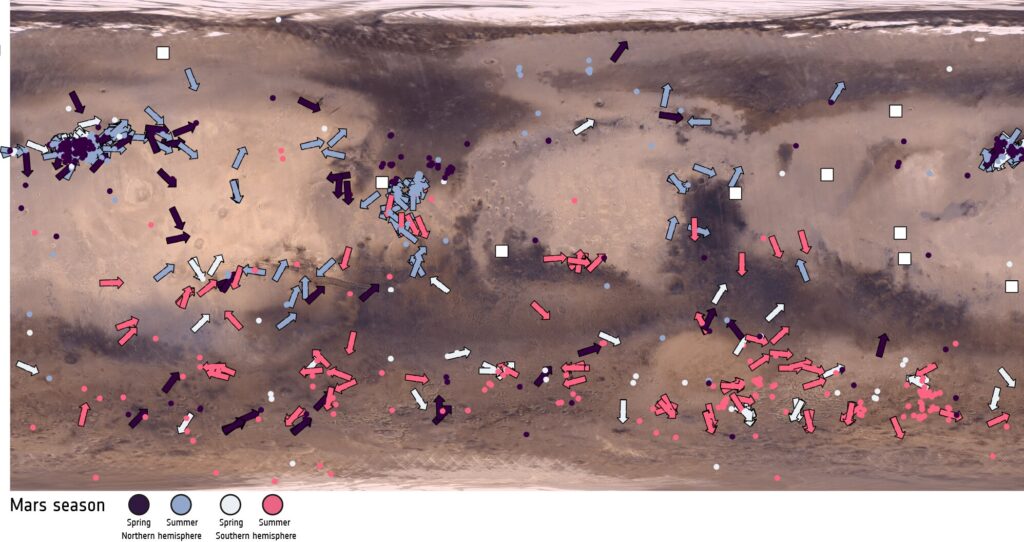
In a groundbreaking study, scientists have meticulously mapped 1,039 dust devils on Mars, uncovering that the strongest winds on the Red Planet blow much faster than previously believed. This revelation comes after analyzing two decades of images from the European Space Agency’s Mars Express and ExoMars Trace Gas Orbiter spacecraft. Published in Science Advances, these findings offer a clearer understanding of Martian weather and climate, with significant implications for future missions.
The research not only enhances our scientific knowledge but also holds practical applications for upcoming Mars missions. The study’s comprehensive catalog of dust devils will aid in planning strategies to mitigate the accumulation of dust on solar panels of robotic rovers, a persistent challenge in Martian exploration.
Mapping Mars: A New Frontier in Meteorology
Dust devils have been observed on Mars for decades, but this study marks the first time their motion has been systematically tracked to understand their travel across the planet’s surface. Led by Valentin Bickel from the University of Bern, Switzerland, the research has produced the first global catalog detailing the speeds and directions of these whirlwinds.
“Dust devils make the normally invisible wind visible,” explains Valentin. “By measuring their speed and direction of travel, we have started mapping the wind all over Mars’s surface. This was impossible before because we didn’t have enough data to make this kind of measurement on a global scale.”
Mars, with its dramatic landscape of vast volcanoes and deep craters, presents a unique environment where dust plays a critical role. Unlike Earth, where rain clears the air, Martian dust can linger in the atmosphere, influencing temperature and cloud formation. Understanding how and when dust is lifted is crucial for comprehending Mars’s climate.
Unveiling the Secrets of Martian Winds
The study employed a neural network to identify dust devils in images captured by Mars Express since 2004 and ExoMars TGO since 2016. The resulting map shows the locations and movement directions of these dust devils, revealing that many originate from specific “source regions” like Amazonis Planitia, a dust and sand-covered area.
Researchers discovered wind speeds reaching up to 44 m/s (158 km/h), surpassing previous measurements from ground rovers. However, due to Mars’s thin atmosphere, such winds would be barely perceptible to a human. The study indicates that in regions where wind speeds exceed expectations, more dust may be lifted than previously realized.
Seasonal Patterns and Earthly Parallels
Similar to Earth, Mars experiences seasons, and the catalog highlights that dust devils are most prevalent during the spring and summer of each hemisphere. They typically last a few minutes and occur during the daytime, peaking between 11:00 and 14:00 local solar time. This pattern mirrors dust devil activity on Earth, which is common in dry, dusty regions during late morning to early afternoon in summer.
Implications for Future Mars Exploration
This extensive dataset is invaluable for refining Mars climate models, which have so far relied on limited data from missions covering only small portions of the planet. Improved models enhance our understanding of Martian wind patterns, crucial for the safe arrival of future landers and rovers.
“Information on wind speeds and directions is also really important when planning the arrival of future landers and rovers at Mars,” mentions Valentin. “Our measurements could help scientists build up an understanding of wind conditions at a landing site before touchdown, which could help them estimate how much dust might settle on a rover’s solar panels—and therefore how often they should self-clean.”
Already, dust data is shaping mission planning. The ExoMars Rosalind Franklin rover, scheduled to land in 2030, will avoid the planet’s global dust storm season. The public catalog of dust devil tracks continues to grow as Mars Express and ExoMars TGO capture new images daily.
Turning Image Noise into Scientific Gold
Interestingly, Mars Express and ExoMars TGO were not originally designed to measure wind speeds. Valentin’s team ingeniously utilized a normally unwanted feature of the data—color offsets caused by image delays—to track dust devils. This innovative approach turned what was once considered image noise into valuable scientific measurements.
Mars Express’s imaging sequence, with delays of 7 to 19 seconds between channels, allowed researchers to measure dust devil speeds. ExoMars TGO’s CaSSIS system, with longer delays, enabled the observation of dust devil movements over greater distances.
“It’s great to see researchers using Mars Express and ExoMars TGO for totally unexpected research,” says Colin Wilson, ESA project scientist for both missions. “Dust affects everything on Mars—from local weather conditions to how well we can take images from orbit. It’s difficult to understate the importance of the dust cycle.”
As the catalog expands, researchers can direct more images to dust devil hotspots, coordinating missions to capture the same events simultaneously. This collaborative effort promises to refine our understanding of Martian winds, paving the way for safer and more efficient exploration of the Red Planet.





